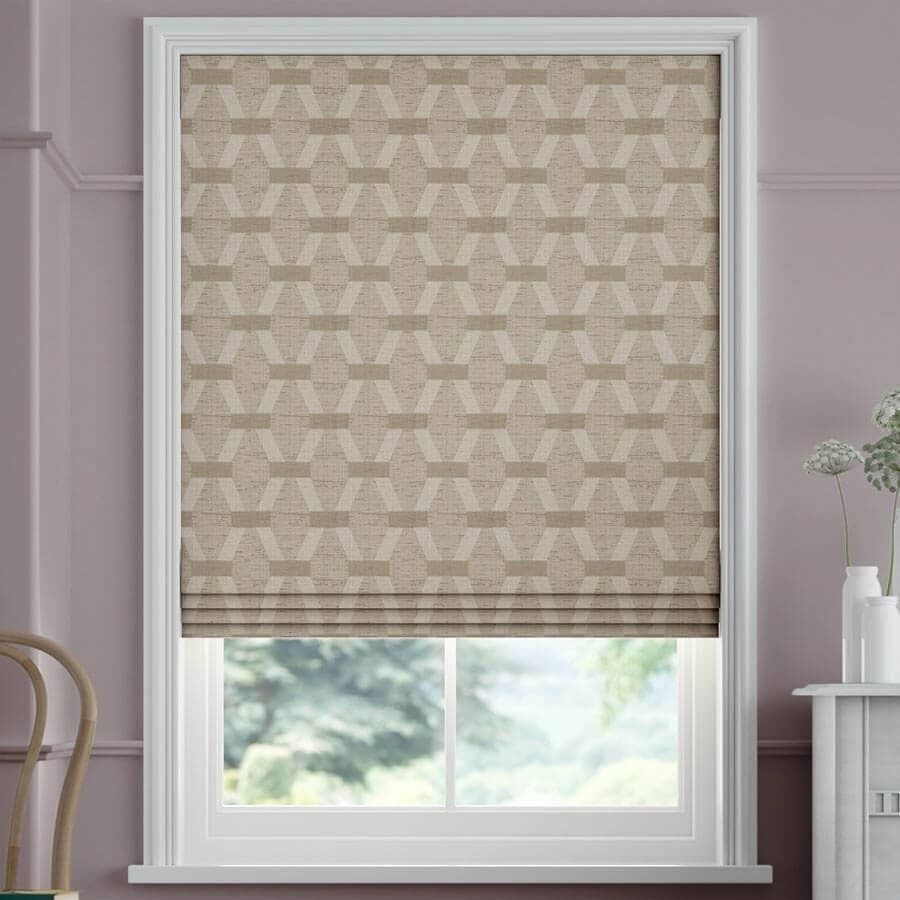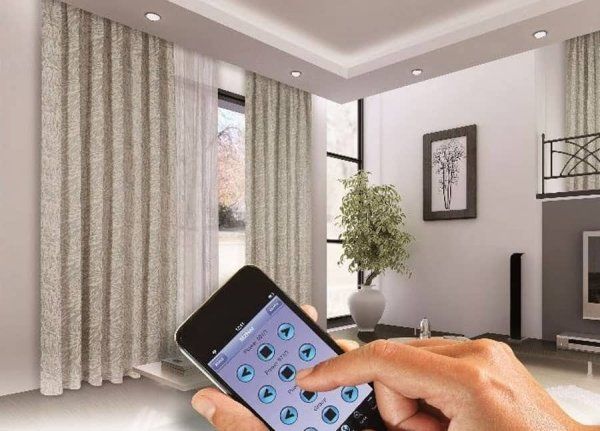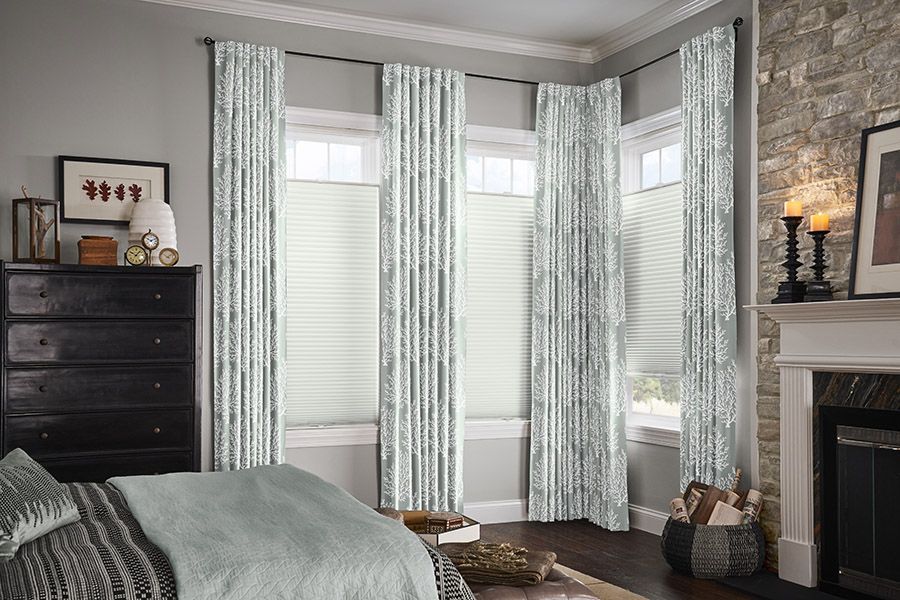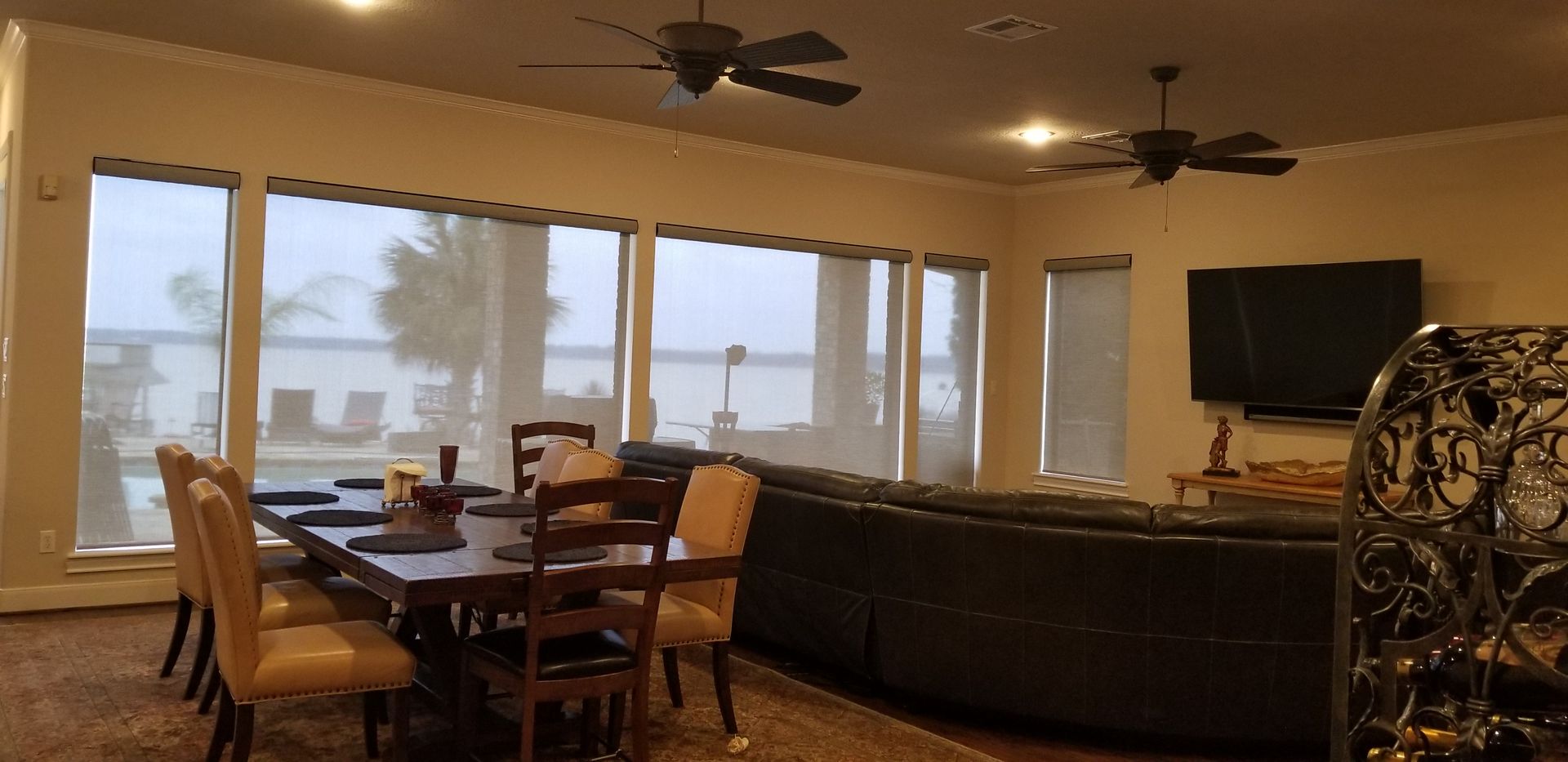Different Types of Blinds for Windows
The Ultimate Guide to Different Types of Blinds: Expert Insights for Every Home
Are you considering new types of window blinds for your home but feeling overwhelmed by the options? Whether you're searching for something that provides complete privacy, efficient light control, or a modern aesthetic, the right types of blinds for windows can transform any room. As a blinds expert with over 2000+ installations across the USA, I understand the common challenges homeowners face when selecting different types of blinds and will help you find the best solution for your needs.
In this guide, we'll explore 19 different types of blinds, including the most popular types of curtains and blinds, their unique features, benefits, and which ones are right for your home. Let's dive in!
1) Wood Blinds
Wood blinds are one of the most traditional and timeless types of window blinds. Made from real wood, they add a touch of natural warmth and sophistication to any room.
Best For: Living rooms, dining rooms, and bedrooms with traditional or rustic decor.
Advantages:
- Insulation benefits: Wood blinds offer great insulation, keeping rooms warmer in the winter and cooler in the summer.
- Wide range of stains and finishes to match any décor.
Pain Points:
Not suitable for high-humidity areas: Wood blinds may warp in kitchens, bathrooms, or other humid areas.
Higher price point compared to other types of blinds.
Expert Advice
Wood blinds work beautifully in spaces where warmth and elegance are needed. If you're looking for types of blinds for windows that provide insulation and luxury, real wood is a fantastic option.
2) Faux Wood Blinds
If you love the look of wood but need something more durable, faux wood blinds are a perfect alternative. These blinds mimic the appearance of real wood but are made from synthetic materials, making them moisture resistant.
Best For: Kitchens, bathrooms, and humid environments.
Advantages:
- Moisture-resistant: Perfect for high-humidity areas like bathrooms or kitchens.
- More affordable than real wood while still providing a high-end appearance.
Pain Points:
Heavier than real wood, which can make larger blinds harder to lift.
Expert Tip:
Faux wood blinds are a great choice for homeowners who want the look of wood but need a more practical and affordable option. This is one of the most popular types of window blinds for households with children or pets.
3) Metal Blinds
Metal blinds are a highly durable and cost-effective solution. Often made from aluminum, these blinds are perfect for modern homes or commercial spaces.
Best For: Kitchens, bathrooms, and offices.
Advantages:
- Durable and rust-resistant, perfect for high-use areas.
- Lightweight and available in various finishes to match your interior.
Pain Points:
- Can be noisy when adjusted.
- Slats are prone to bending if mishandled.
Expert Advice:
If you're looking for different types of window blinds that are affordable, durable, and modern, metal blinds are an excellent option for both residential and commercial use.
4) Mini Blinds
Mini blinds are a compact and budget-friendly version of Venetian blinds, featuring narrow slats that are ideal for smaller windows or compact spaces.
Best For: Apartments, small offices, and compact spaces.
Advantages:
- Inexpensive and widely available in a range of colors.
- Space-saving design for smaller rooms.
Pain Points:
- May collect dust quickly due to the smaller slat size.
- Less durable than other types of blinds.
Expert Tip:
Mini blinds are an ideal choice for rental properties or temporary solutions. They offer versatility in design while being highly cost-effective.
5) Vertical Blinds
Vertical blinds are designed with long slats that move horizontally along a track, making them ideal for covering large windows or sliding doors.
Best For: Patio doors, large windows, and commercial spaces.
Advantages:
- Versatile and easy to maintain, vertical blinds are perfect for large spaces.
- Available in materials like fabric, vinyl, or aluminum.
Pain Points:
- Slats may become misaligned over time.
- Can be noisy if exposed to wind or drafts.
Expert Advice:
Vertical blinds are great for covering large spaces efficiently, especially if you're dealing with sliding doors or floor-to-ceiling windows.
6) Roller Blinds
Roller blinds offer a simple and clean design, perfect for modern and minimalist interiors. These blinds are made from a single piece of fabric that rolls up or down, providing easy light control and privacy.
Best For: Bedrooms, offices, and kitchens.
Advantages:
- Available in a variety of fabrics, including blackout for full privacy and light control.
- Simple and sleek design that fits well in any modern home.
Pain Points:
- Limited insulation properties compared to blinds with slats.
- Fabric may collect dust, requiring regular cleaning.
Expert Tip:
If you're looking for types of blinds for windows that offer clean lines and versatile designs, roller blinds are a perfect fit. Consider motorized roller blinds for added convenience.
7) Solar Shades
Solar shades are a type of roller blind specifically designed to block UV rays and reduce glare while still allowing natural light to filter through.
Best For: Sunrooms, patios, and large windows with high sun exposure.
Advantages:
- Blocks UV rays, protecting your furniture and floors.
- Reduces glare while maintaining visibility to the outside.
Pain Points:
Limited privacy at night.
Expert Advice:
Solar shades are ideal for rooms that receive a lot of sunlight. They help to reduce heat and glare, making them a popular choice for sunrooms or large windows.
8) Venetian Blinds
Venetian blinds, one of the most classic types of blinds, feature horizontal slats that can be adjusted for light control. They are available in a variety of materials, including wood, faux wood, and metal.
Best For: Living rooms, bedrooms, and kitchens.
Advantages:
- Flexible light control thanks to the adjustable slats.
- Suitable for a wide range of interiors, from traditional to modern.
Pain Points:
Slats can collect dust easily and may require frequent cleaning.
Expert Tip:
Venetian blinds are a versatile choice for almost any room. For homes in humid climates, faux wood Venetian blinds are a great solution to prevent warping.
9) Zebra Blinds
Zebra blinds, also known as dual-layer blinds, feature alternating strips of solid and sheer fabric. These blinds allow for dynamic light control by aligning the layers for full privacy or full visibility.
Best For: Bedrooms, offices, and living rooms.
Advantages:
- Modern and sleek design that fits contemporary homes.
- Allows for both privacy and light control.
Pain Points:
Less insulation compared to heavier blinds.
Expert Tip:
Zebra blinds are perfect for those who want a contemporary look combined with flexible light control. They work particularly well in home offices and bedrooms where style and functionality are important.
10) Roman Blinds
Roman blinds are one of the most elegant and timeless types of window treatments available. When raised, these blinds fold into pleats, creating a soft and luxurious look. Roman blinds are popular for their ability to bring warmth and sophistication to any room.
Best For: Bedrooms, living rooms, dining rooms, and spaces that need a touch of elegance.
Advantages:
- Versatile design: Available in a wide range of fabrics, colors, and textures.
- Offers excellent light control, especially with options for blackout or light-filtering fabrics.
Pain Points:
Can be bulky when raised, which may block part of the window.
Requires regular maintenance to avoid dust accumulation on fabric folds.
Expert Tip:
Roman blinds are a great choice if you're looking to create a luxurious, cozy atmosphere in your home. Consider adding thermal or blackout lining to increase their insulation and light-blocking capabilities.
11) Woven Blinds
Woven blinds, often referred to as natural blinds, are made from organic materials like bamboo, jute, or reeds. These blinds add a textured, earthy feel to any space, making them perfect for homes looking for a natural aesthetic.
Best For: Beach houses, rustic homes, or any room needing a natural, organic look.
Advantages:
- Eco-friendly and sustainable materials.
- Adds a warm, textured look to any space, making it feel more connected to nature.
Pain Points:
- Limited light control unless lined.
- Privacy may be an issue without additional lining.
Expert Advice:
Woven blinds are an excellent way to bring natural elements into your home, but I always recommend adding a fabric liner if you want better light control and privacy. They work wonderfully in living spaces that need to feel more grounded and earthy.
12) Cellular (Honeycomb) Blinds
Cellular blinds, also known as honeycomb shades, are designed with a unique honeycomb structure that traps air, making them one of the most energy-efficient types of blinds available. These blinds help to regulate temperature, keeping your home cooler in the summer and warmer in the winter.
Best For: Bedrooms, living rooms, and any room where energy efficiency is important.
Advantages:
- Excellent insulation, which helps reduce energy bills.
- Available in various light-filtering and blackout options for better control over light and privacy.
Pain Points:
- May be more expensive than other types of blinds.
- Less decorative than other options like Roman or zebra blinds.
Expert Advice:
Cellular blinds are ideal for homeowners looking to improve energy efficiency. If you're concerned about your heating and cooling costs, these blinds can help regulate indoor temperature and save money in the long run.
13) Top-Down Bottom-Up Blinds
Top-down bottom-up blinds provide maximum flexibility in light control and privacy. As the name suggests, these blinds can be opened from both the top and the bottom, allowing you to maintain privacy while still letting in natural light.
Best For: Bedrooms, bathrooms, and living rooms.
Advantages:
- Flexible privacy: Perfect for rooms where you want to maintain privacy but also allow in light.
- Great for high-traffic areas like street-facing rooms or windows overlooking neighbors.
Pain Points:
- More expensive than standard blinds due to their advanced mechanism.
- Can be harder to install compared to simpler blinds.
Expert Advice:
If you live in a busy neighborhood and want to enjoy natural light without sacrificing privacy, top-down bottom-up blinds are a game-changer. They're particularly useful in bathrooms and bedrooms where privacy is key but you still want access to daylight.
14) Cordless Blinds
Cordless blinds are designed without the traditional pull cords, making them child-safe and giving a streamlined appearance. These blinds are operated by simply pushing or pulling the bottom rail, offering a neat and modern look.
Best For: Homes with children or pets, living rooms, and bedrooms.
Advantages:
- Safe for children and pets as there are no dangling cords.
- Sleek and modern appearance, perfect for minimalist spaces.
Pain Points:
- May be harder to operate on larger windows.
- More expensive due to the specialized mechanism.
Expert Tip:
Cordless blinds are the perfect solution for families with young children or pets, where safety is a priority. Plus, their sleek look complements modern, minimalist interiors beautifully.
15) Motorized Blinds
Motorized blinds are the epitome of modern convenience. With the ability to control your blinds with the push of a button or via a smartphone app, these blinds are perfect for hard-to-reach windows or homeowners who want to incorporate smart home technology.
Best For: Smart homes, home theaters, and large or hard-to-reach windows.
Advantages:
- Convenient and easy to control remotely.
- Can be integrated with smart home systems like Alexa, Google Home, or Apple HomeKit.
Pain Points:
- Higher upfront cost due to the motorization and installation.
- Requires a power source, either battery or wired, which may limit placement.
Expert Advice:
Motorized blinds are ideal for luxury homes or homeowners looking for the latest in convenience. They're especially popular for home theaters were darkening the room at the push of a button is a must-have feature.
16) Aluminum Blinds
Aluminum blinds are a lightweight, cost-effective option that is perfect for high-use areas like kitchens and bathrooms. These blinds are often made from rust-resistant materials, making them durable and long-lasting.
Best For: Kitchens, bathrooms, and offices.
Advantages:
- Durable and rust-resistant, making them ideal for areas with moisture.
- Available in a wide range of colors and finishes to match any décor.
Pain Points:
- Can be noisy when operated.
- Slats may bend or dent if handled roughly.
Expert Tip:
Aluminum blinds are a practical and durable choice for homes or offices. They’re especially ideal for high-moisture areas like kitchens or bathrooms due to their rust-resistant properties.
17) Panel Track Blinds
Panel track blinds consist of large fabric panels that slide along a track, making them a great option for large windows or sliding doors. Their clean, modern appearance makes them a popular choice for contemporary homes.
Best For: Sliding doors, large windows, and room dividers.
Advantages:
- Perfect for large spaces like sliding glass doors or floor-to-ceiling windows.
- Can also be used as a room divider in open-plan homes.
Pain Points:
- Takes up more space when opened compared to other blinds.
- Limited light control options.
Expert Advice:
If you have a modern, open-plan home, panel track blinds offer a sleek, stylish solution for large windows or even as a divider between spaces.
18) Pleated Blinds
Pleated blinds are made from a pleated fabric that folds into an accordion-like shape when raised. They offer a more affordable option than cellular blinds while still providing a neat, sleek appearance.
Best For: Offices, small rooms, and budget-conscious homeowners.
Advantages:
- Affordable and easy to install.
- Simple, modern appearance that fits well in offices or small spaces.
Pain Points:
- Less energy-efficient than cellular blinds.
- Fabric may lose its shape over time if not cared for properly.
Expert Advice:
Pleated blinds are a great budget-friendly solution for small windows or rooms where insulation isn’t a top concern. They’re a popular choice for office spaces and study areas.
19) Smart Blinds
Smart blinds are the future of window treatments, allowing you to control your blinds via voice commands or through an app on your smartphone. These blinds integrate seamlessly with smart home systems, providing the ultimate in convenience and automation.
Best For: Tech-savvy homeowners, smart homes, and hard-to-reach windows.
Advantages:
- Voice-activated control via systems like Amazon Alexa or Google Home.
- Can be programmed to open and close automatically based on your daily schedule.
Pain Points:
- High upfront cost for smart home integration.
- Requires a strong Wi-Fi connection and reliable power source.
Expert Tip:
Smart blinds are perfect for modern homes looking for convenience and automation. Whether you're automating your morning routine or controlling hard-to-reach windows, smart blinds are an innovative solution that brings luxury and functionality together.
Conclusion: Choosing the Right Types of Blinds for Your Home
Now that you're familiar with all 19 types of blinds, you have a comprehensive understanding of what each type offers in terms of style, functionality, and benefits. Whether you're looking for energy efficiency, privacy, or simply a modern upgrade for your windows, there’s a perfect blind for every room in your home.
With over 2000 successful blind installations across the USA, I can help you make the right decision for your space. If you're ready to take the next step, contact me today to discuss your needs and get expert advice on the best types of window blinds for your home.
For more personalized recommendations,
schedule a free consultation and let’s find the perfect solution for window blinds.
GALLERY WINDOW FASHIONS
- Mon - Fri
- -
- Saturday
- Appointment Only
- Sunday
- Closed





